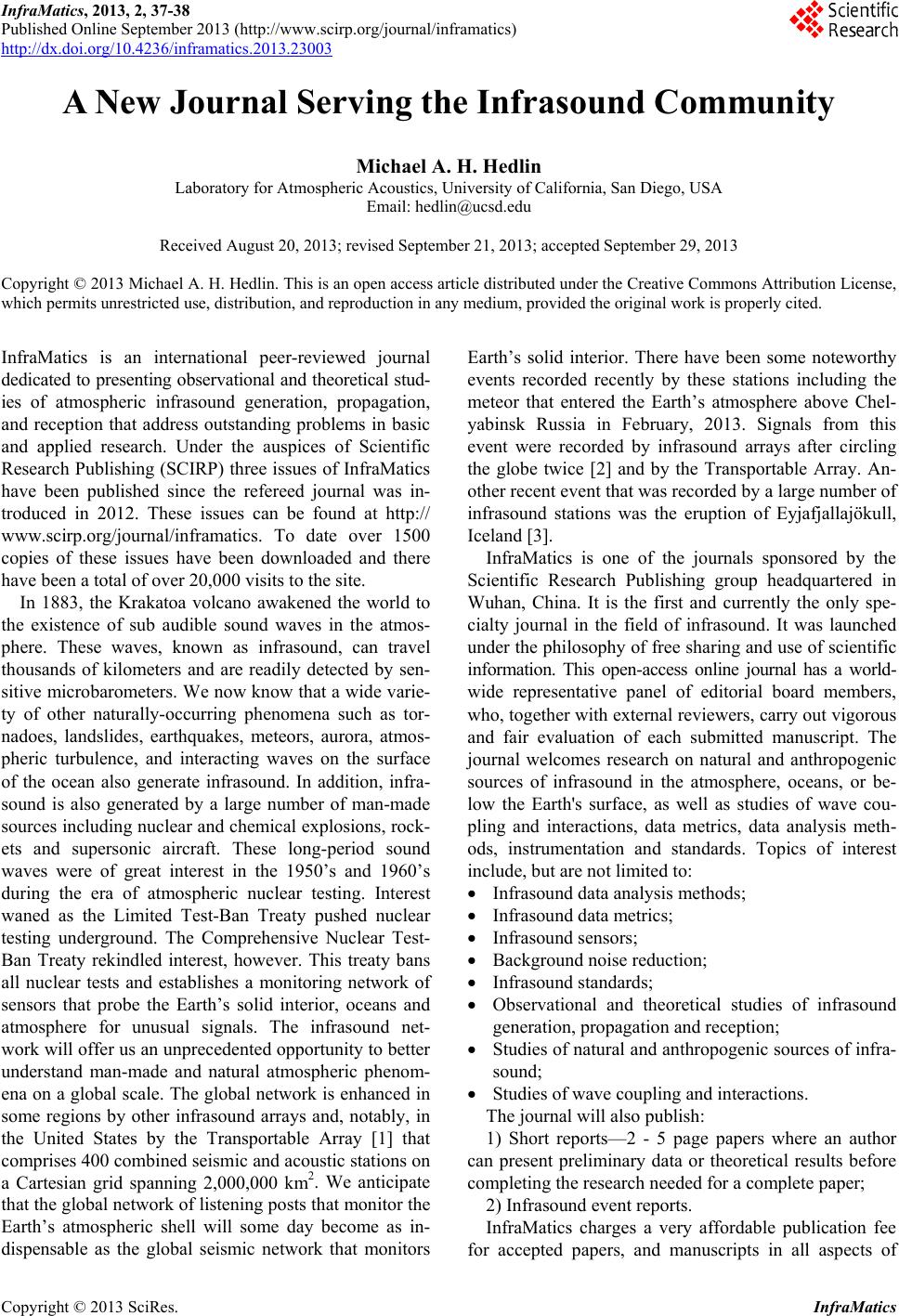
InfraMatics, 2013, 2, 37-38
Published Online September 2013 (http://www.scirp.org/journal/inframatics)
http://dx.doi.org/10.4236/inframatics.2013.23003
Copyright © 2013 SciRes. InfraMatics
A New Journal Serving the Infrasound Community
Michael A. H. Hedlin
Laboratory for Atmospheric Acoustics, University of California, San Diego, USA
Email: hedlin@ucsd.edu
Received August 20, 2013; revised September 21, 2013; accepted September 29, 2013
Copyright © 2013 Michael A. H. Hedlin. This is an open access article distributed under the Creative Commons Attribution License,
which permits unrestricted use, distribution, and reproduction in any medium, provided the original work is properly cited.
InfraMatics is an international peer-reviewed journal
dedicated to presenting observational and theoretical stud-
ies of atmospheric infrasound generation, propagation,
and reception that address outstanding problems in basic
and applied research. Under the auspices of Scientific
Research Publishing (SCIRP) three issues of InfraMatics
have been published since the refereed journal was in-
troduced in 2012. These issues can be found at http://
www.scirp.org/journal/inframatics. To date over 1500
copies of these issues have been downloaded and there
have been a total of over 20,000 visits to the site.
In 1883, the Krakatoa volcano awakened the world to
the existence of sub audible sound waves in the atmos-
phere. These waves, known as infrasound, can travel
thousands of kilometers and are readily detected by sen-
sitive microbarometers. We now kn ow that a wide varie-
ty of other naturally-occurring phenomena such as tor-
nadoes, landslides, earthquakes, meteors, aurora, atmos-
pheric turbulence, and interacting waves on the surface
of the ocean also generate infrasound. In addition, infra-
sound is also generated by a large number of man-made
sources including nuclear and chemical explosions, rock-
ets and supersonic aircraft. These long-period sound
waves were of great interest in the 1950’s and 1960’s
during the era of atmospheric nuclear testing. Interest
waned as the Limited Test-Ban Treaty pushed nuclear
testing underground. The Comprehensive Nuclear Test-
Ban Treaty rekindled interest, however. This treaty bans
all nuclear tests and establishes a monitoring network of
sensors that probe the Earth’s solid interior, oceans and
atmosphere for unusual signals. The infrasound net-
work will offer us an unpreced ented opportun ity to better
understand man-made and natural atmospheric phenom-
ena on a global scale. The global network is enhanced in
some regions by other infrasound arrays and, notably, in
the United States by the Transportable Array [1] that
comprises 400 combined seismic and acoustic stations on
a Cartesian grid spanning 2,000,000 km2. We anticipate
that the global network of listening posts that monitor the
Earth’s atmospheric shell will some day become as in-
dispensable as the global seismic network that monitors
Earth’s solid interior. There have been some noteworthy
events recorded recently by these stations including the
meteor that entered the Earth’s atmosphere above Chel-
yabinsk Russia in February, 2013. Signals from this
event were recorded by infrasound arrays after circling
the globe twice [2] and by the Transportable Array. An-
other recent event that was recorded by a large number of
infrasound stations was the eruption of Eyjafjallajökull,
Iceland [3].
InfraMatics is one of the journals sponsored by the
Scientific Research Publishing group headquartered in
Wuhan, China. It is the first and currently the only spe-
cialty journal in the field of infrasound. It was launched
under the philosophy of free sharing and use of scientific
information. This open-access online journal has a world-
wide representative panel of editorial board members,
who, together with external reviewers, carry out vigorous
and fair evaluation of each submitted manuscript. The
journal welcomes research on natural and anthropogenic
sources of infrasound in the atmosphere, oceans, or be-
low the Earth's surface, as well as studies of wave cou-
pling and interactions, data metrics, data analysis meth-
ods, instrumentation and standards. Topics of interest
include, but are not limited to:
Infrasound data analysis methods;
Infrasound data metric s;
Infraso und sensors;
Background noise reduction;
Infraso und standards;
Observational and theoretical studies of infrasound
generation, propag a tion and reception;
Studies of natural and anthropogenic sources of infra-
sound;
Studies of wave coupling and interactions.
The journal will also publish:
1) Short reports—2 - 5 page papers where an author
can present preliminary data or theoretical results before
completing the research needed for a complete paper;
2) Infrasound event reports.
InfraMatics charges a very affordable publication fee
for accepted papers, and manuscripts in all aspects of